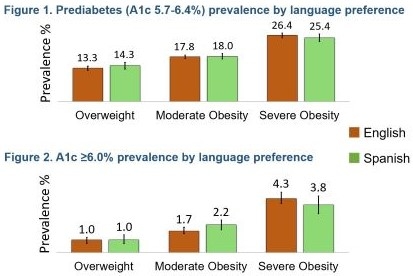Final ID: P3018
Spanish Language Preference is not associated with Prediabetes Risk among Hispanic Adolescents with Overweight or Obesity in an Integrated Healthcare System
Abstract Body: INTRODUCTION:
Nationally, up to 1 in 5 Hispanic adolescents have prediabetes. While obesity and other metabolic risk factors contribute to their disproportionate metabolic risk, fewer studies have examined the role of sociodemographic factors such as language proficiency. In this study, we examined whether primary language preference is associated with differences in prediabetes prevalence among Hispanic youth with overweight or obesity.
METHODS: This retrospective study was conducted using data from Kaiser Permanente Northern California. The cohort included 37,578 Hispanic youth aged 10-17y with body mass index (BMI)≥85th percentile at exam visits in 2013-2019 and hemoglobin A1c measured within 1 year of the visit. Youth with diabetes or A1c ≥6.5% were excluded. Prediabetes (outcome) was defined by A1c ≥5.7%-6.4%. We also examined A1c ≥6% (secondary outcome). Family/self-reported English vs Spanish language preference was obtained from health records. BMI was classified as overweight (85th to <95th percentile) and obesity (≥95th percentile). A neighborhood deprivation index (NDI) was calculated using area of residence and US Census data. Modified Poisson regression was used to examine the association of language preference with prediabetes, reporting relative risks (RR) and 95% confidence intervals [CI].
RESULTS: The cohort included 37,578 Hispanic youth (mean age 13.1±2.3y), of whom 26,910 (71.6%) reported English and 10,668 (28.4%) reported Spanish as their preferred language. Prediabetes prevalence was 19.3% for both English and Spanish language groups and was similar among those with overweight (13.3% vs 14.3%) and obesity (21.4% vs 21.0%). Adjusting for age, sex, NDI quartile, and BMI (percent of 95th percentile), the risk of prediabetes for those with Spanish language preference remained similar to those with English language preference (RR 0.99 [0.95-1.04]. There were no differences within overweight or obesity subgroups, when A1c ≥6.0% was used as the outcome, and when analyses were restricted to older or younger age subsets.
CONCLUSION: Prediabetes prevalence was similar among Hispanic youth with elevated BMI who had Spanish compared to English language preference. While differences in dietary and lifestyle factors were not examined, these findings point to similar metabolic risk profiles among Hispanic youth regardless of language preference, when examined in a healthcare system focused on preventive health and uniform access to language services.
Nationally, up to 1 in 5 Hispanic adolescents have prediabetes. While obesity and other metabolic risk factors contribute to their disproportionate metabolic risk, fewer studies have examined the role of sociodemographic factors such as language proficiency. In this study, we examined whether primary language preference is associated with differences in prediabetes prevalence among Hispanic youth with overweight or obesity.
METHODS: This retrospective study was conducted using data from Kaiser Permanente Northern California. The cohort included 37,578 Hispanic youth aged 10-17y with body mass index (BMI)≥85th percentile at exam visits in 2013-2019 and hemoglobin A1c measured within 1 year of the visit. Youth with diabetes or A1c ≥6.5% were excluded. Prediabetes (outcome) was defined by A1c ≥5.7%-6.4%. We also examined A1c ≥6% (secondary outcome). Family/self-reported English vs Spanish language preference was obtained from health records. BMI was classified as overweight (85th to <95th percentile) and obesity (≥95th percentile). A neighborhood deprivation index (NDI) was calculated using area of residence and US Census data. Modified Poisson regression was used to examine the association of language preference with prediabetes, reporting relative risks (RR) and 95% confidence intervals [CI].
RESULTS: The cohort included 37,578 Hispanic youth (mean age 13.1±2.3y), of whom 26,910 (71.6%) reported English and 10,668 (28.4%) reported Spanish as their preferred language. Prediabetes prevalence was 19.3% for both English and Spanish language groups and was similar among those with overweight (13.3% vs 14.3%) and obesity (21.4% vs 21.0%). Adjusting for age, sex, NDI quartile, and BMI (percent of 95th percentile), the risk of prediabetes for those with Spanish language preference remained similar to those with English language preference (RR 0.99 [0.95-1.04]. There were no differences within overweight or obesity subgroups, when A1c ≥6.0% was used as the outcome, and when analyses were restricted to older or younger age subsets.
CONCLUSION: Prediabetes prevalence was similar among Hispanic youth with elevated BMI who had Spanish compared to English language preference. While differences in dietary and lifestyle factors were not examined, these findings point to similar metabolic risk profiles among Hispanic youth regardless of language preference, when examined in a healthcare system focused on preventive health and uniform access to language services.
More abstracts on this topic:
A Measurement Model of Socioeconomic Status and its Association with Cardiovascular Disease in the Hispanic Community Health Study/Study of Latinos
Cordero Christina, Llabre Maria, Romaker Emma, Kobayashi Marissa, Gianola Morgan, Gallo Linda, Isasi Carmen, Perreira Krista, Corsino Leonor, Zhou Laura
A community-engaged approach to culturally tailoring a dietary intervention to improve cardiometabolic health among Black adults with obesity in Los Angeles CountyAdeyemo Mopelola, Thorpe Roland

